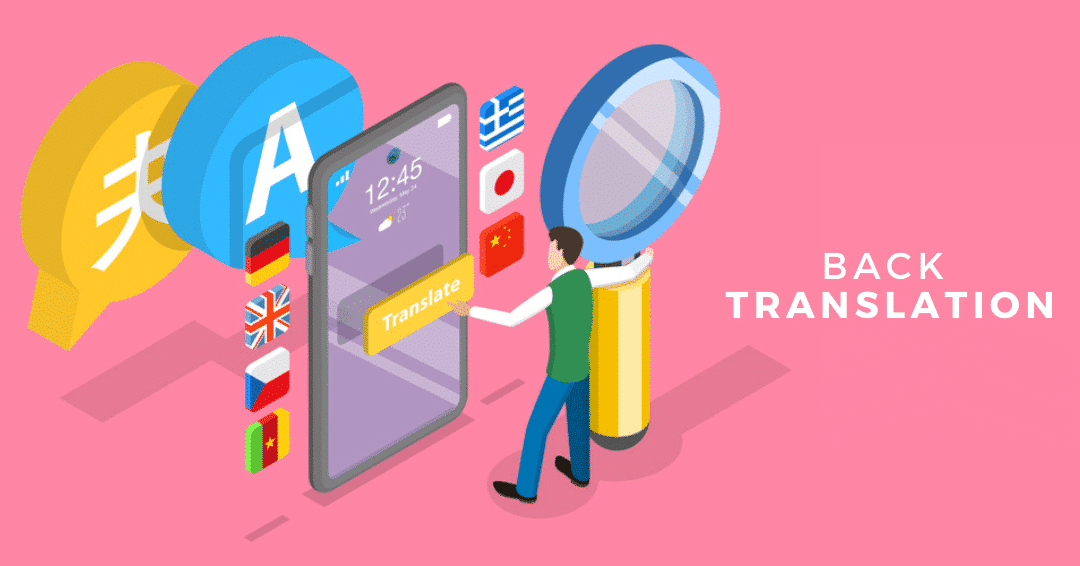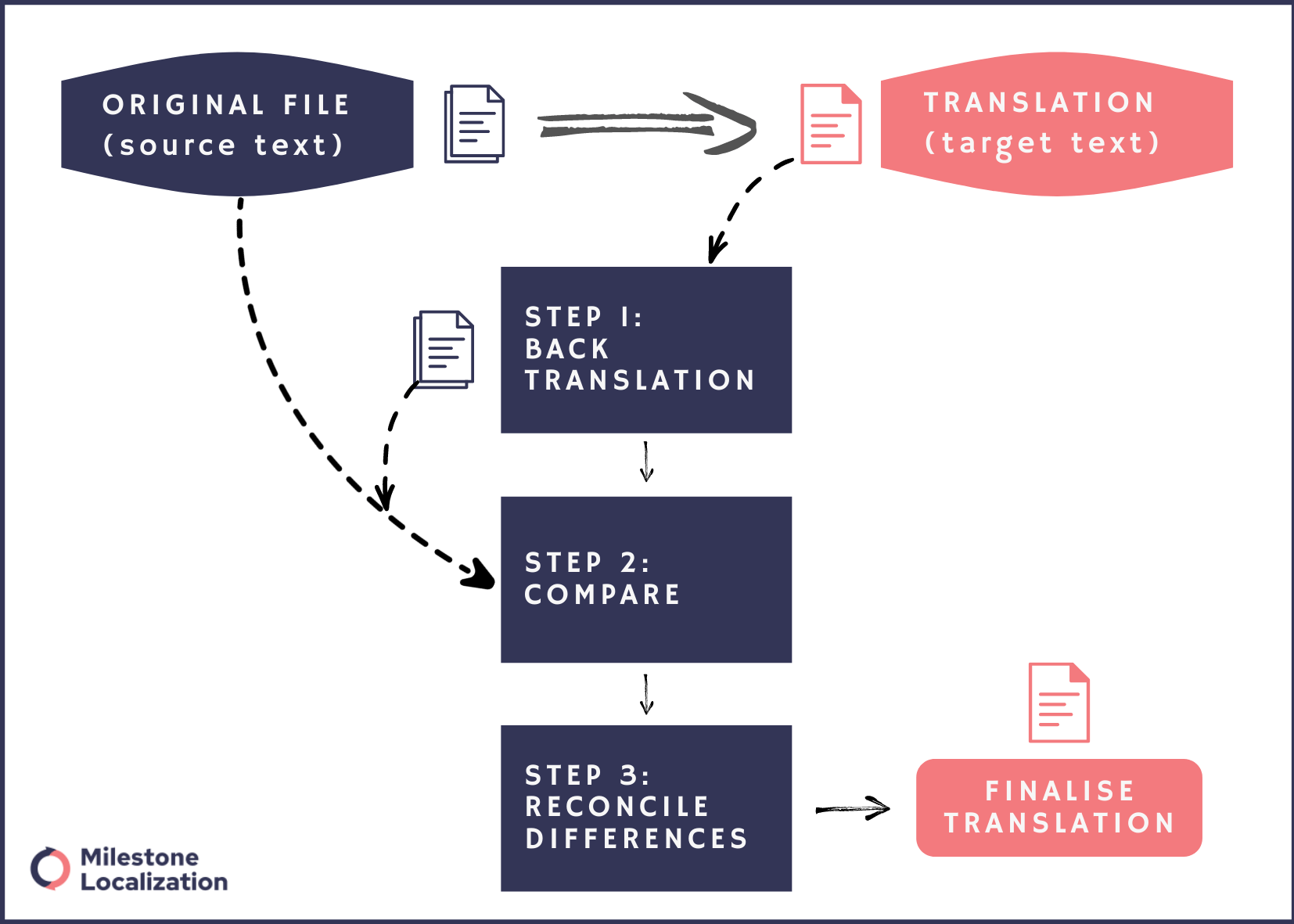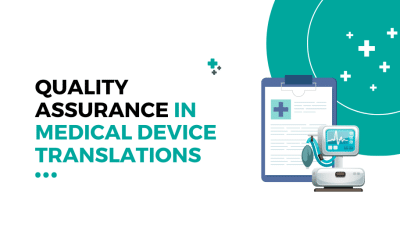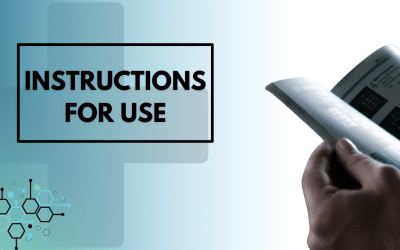Has a client ever asked you for a back translation?
How can a translator prove their translation is the right one?
Of course, there is not one single right translation since one can express the same idea with different words and grammatical structures.
Still, how can you as a client make sure that the linguist has done their job properly and has managed to translate the content accurately?
Keep reading because in this blog we are diving into the topic of BT – a powerful quality assessment tool that ensures that the translation is true to the source.
If you have never heard of BT, there is no need to worry. Below you will find the questions you might be asking yourself right now.
1. What is back translation (BT)?
Before we begin, we should differentiate between two very important terms which translators often use.
Let’s start with a source language. This is the language a text is translated from. A target language, on the other hand, is the language that the text is translated into.
Now we can move on to BT.
Back-translation, also referred to as reverse translation, is a process whereby content is re-translated from the target language to its source language.
For instance, if we have translated a text from English, which is the source language, into Bulgarian, the target language, we can do a BT by re-translating it into English (or its the source language).
It should be pointed out that BT follows one simple principle – when re-translating the target text one should not consider the source text.
This is why companies use a different linguist who is not familiar with the source text to do the BT. In fact, the linguist should regard the target text as a source one, as confusing as it might sound.
Check Out: GLOBAL LANGUAGE FACTS
2. Why is back translation beneficial?
Back-translation is a great method for quality assurance. By re-translating the content into its source language you can review the translation in a language you understand.
This is usually done by a different linguist and not the one who has done the initial translation.
While this method is not very useful for spotting grammar or spelling mistakes, it comes in handy to find any meaning-related issues in the target text.
Back-translation is greatly beneficial to the client as well. You can use BT to make sure an agency has done their job properly and they have translated your content without any mistakes.
Companies always use another linguist for the BT to guarantee quality and prevent bias.
Overall, by doing a BT the client is assured that the translated content is indeed accurate and conveys the same message as the source.
For linguists, re-translating the target text can help better identify any semantical mistakes such as ambiguity or confusion.
This also helps to evaluate the meaning nuances of words in the source and the target languages.
Overall, back-translation is a great way to assess the precision, accuracy, and quality of the target text.
Check Out: LANGUAGE INFOGRAPHIC GALLERY
3. When is it best to use back translation?
Back-translation is most frequently used for critical content that must be as accurate as possible. There are two main types of content that can be considered high risk and thus, perfection is a must:
- Medical documents such as clinical trials and research, medical devices, consent forms as well as pharmaceutical documentation.
- Legal documents such as contracts, insurance policies, case files, and legal-related paperwork as well as binding documents.
Also Read: The Right Way To Do Medical Translation
In both medical software and legal documentation, mistranslations might have severe consequences. Therefore, translations should be done cautiously and quality assurance such as back-translation is imperative.
Also Read: Legal Translation – 6 Practical Tips for Translating Legal Documents
Back-translation can be greatly beneficial to other types of content:
- Finance-related documents such as reports, reviews, and regulatory requirements.
- Manufacturing– or product-related documents such as instructions and safety manuals, packaging as well as paperwork.
While these texts are not as high risk as to the aforementioned medical and legal documents, one might use the back-translation for the same purpose – to make sure there are no errors.
Also read: ICF Translation: Importance, Requirements & Best Practices
4. What would be an example of back translation?
Back translation might seem like a very confusing method, but believe me – this is not the case. To make sure there is no misunderstanding, here is a practical example of back translation process.
On the left side is the source text in English which is translated into the target language – in this case, this is Bulgarian.
Now we can move on to the next step – back translation. For this purpose, we take the target text and without considering the source text, we re-translate it into English.
The back translation process is done, now it is time to compare the source text and the back translation. The aim of this process is to spot any possible mistakes.
As you can see there are some differences between the two texts, however, the job of the translator is to look out for any error that might cause misunderstanding or confusion.
Therefore, this method is very suitable when looking for semantic mistakes in a translation rather than misspelled words or incorrect grammar.
Also Read: 7 Reasons To Work With a Translation Company on Your Next Project
5. What does the back translation process look like?
Finally, here is what the back translation process looks like:
- The text is translated into the target language. In the case of the above example, the target language is Bulgarian.
- Then the content (or a specific part of it), which is in the target language, is translated back to its original, source language (in this case English) by a different linguist who is not familiar with the original source text.
- The linguist, the project manager, or the client compares the two versions of the text and looks for possible inaccuracies.
- If there are any errors in the back translation, the linguist goes back to the target text (the initial translation of the source text) to correct them.
To conclude…
Back translation is a powerful tool. It is a great way for monolinguals to verify the quality and accuracy of a translation.
This process is usually used in medical and legal texts, but can also be beneficial for tests, manuals, safety instructions, and critical communications.
Have an important document you need to be translated accurately? Set up a call with our team and we’ll see if the back translation is suitable for your project.








